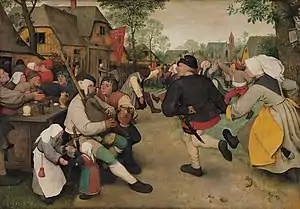The Peasant Dance
The Peasant Dance is an oil-on-panel by the Netherlandish Renaissance artist Pieter Bruegel the Elder, painted in circa 1567. It was looted by Napoleon Bonaparte and brought to Paris in 1808, being returned in 1815.[1] Today it is held by and exhibited at the Kunsthistorisches Museum in Vienna.
| The Peasant Dance | |
|---|---|
 | |
| Artist | Pieter Bruegel the Elder |
| Year | 1567 |
| Type | Oil on panel |
| Dimensions | 114 cm × 164 cm (45 in × 65 in) |
| Location | Kunsthistorisches Museum, Vienna |
Description
The panel, neither signed nor dated, was painted circa 1567, at about the same time as The Peasant Wedding. The paintings are the same size and may have been intended as a pair or as part of a series illustrating peasant life.[2] They are the two most outstanding examples of Bruegel's late style, which is characterized by his use of monumental Italianate figures.[3]
Details
_-_WGA3502.jpg.webp)
Like The Peasant Wedding, it is likely that Bruegel intended this painting to have a moral sense rather than simply being an affectionate portrayal of peasant life. Gluttony, lust and anger can all be identified in the picture. The man seated next to the bagpipe player wears a peacock feather in his hat, a symbol of vanity and pride.[4] The occasion for the peasants' revelry is a Saint's day, but dancers turn their backs on the church and pay no attention whatsoever to the image of the Virgin Mary which hangs on the tree. The prominence of the tavern makes it clear that they are preoccupied with material rather than spiritual matters.[5]
References
- Danza di contadini.
- Cf. Pietro Allegretti, Brueghel, Skira, Milano 2003. ISBN 0-00-001088-X (in Italian)
- There is another version of this subject by Bruegel in a painting in the Detroit Institute of Arts, entitled The Wedding Dance (see image at Wikimedia: "Bruegel dance 1566 Detroit"). It is dated 1566 and although the surface is rather worn, it is today generally accepted as an authentic work from Bruegel's own hand. The composition is more crowded and in consequence more effective than the Vienna picture.
- See Grove Art Online Archived 2012-04-06 at the Wayback Machine
- Screech, Matthew (2005). Masters of the ninth art: bandes dessinées and Franco-Belgian identity. Liverpool University Press. p. 85. ISBN 9780853239383.
External links
| Wikimedia Commons has media related to The Peasant Dance. |
